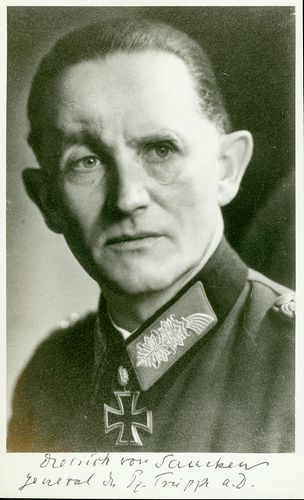Born: 16.05.1892 Fischhausen/Ostpreußen
Died: 27.09.1980 München/Bayem
Few officers in the German Wehrmacht personified the aristocratic Prussian Junker-officer as did von Saucken. The monocle’d general came from a long lineage of Prussian nobility dating back to the fourteenth century. He was one of the few high ranking members of the Wehrmacht who was neither intimidated by Hitler’s insane ravings nor hypnotized by his charisma when he – like many others- was summoned to the Fuehrer’s headquarters to explain why he had made a clever tactical withdrawal instead of ordering his troops to stay put and be massacred by vastly superior Russian forces.
Born 1892 in East Prussia as the son of a judge, von Saucken entered the Imperial Army in 1910 and served in the cavalry regiment “Kaiser Wilhelm I” as a Lieutenant. During WW I he was wounded seven times and finished the war with the rank of Captain. Between the wars he continued to serve with the Reichwehr in various cavalry detachments.
Dietrich von Saucken fought in Poland in 1939 with the cavalry (1st Cavalry Brigade). From fall 1940, he commanded the 4th Rifle Brigade (Schutzenbrigade 4) of 4th Panzer Division. He took the command of the division in December 1941. He was promoted to Major General in 1 January, 1942, but unfortunately he was wounded in the next day, a large chunk of his left eyebrow and forehead having to be removed. He came back to service in August 1942 to a post in training schools, was promoted to Lieutenant General in 1943.
In late 1944 he was G.O.C. Group von Saucken north of Minsk organising counterattacks to stop the Great Russian ‘Bagration’ Offensive. He commanded a Panzer Group on the Oder in 1945, and a Corps in East Prussia and South Poland consisting of the Grossdeutschland and Hermann Goring Divisions. In February 1945 von Saucken successfully smashed a way through the Russians, who had surrounded his command when the Vistula front collapsed, and led his Corps back to the Oder and safety near Steinau.
In March 1945 he was G.O.C. 2nd Army in Sopot, Gydnia and Danzig areas. His fellow-cavalryman Captain Gerhard Boldt has left a brilliant description of a meeting between Hitler and von Saucken in the Chancellory in March 1945. ‘Slim, elegant, his left hand resting casually on his cavalry sabre, von Saucken saluted and gave a slight bow. This was three outrages at once. He had not given the Nazi salute with raised arm and the words “Heil Hitler”, as had been regulation since 20 July 1944; he had not surrendered his weapon on entering the operations room; and he had kept his monocle in his eye when saluting Hitler….’ Guderian and Bormann, who were present, seemed turned to stone, but Hitler merely asked Guderian to brief von Saucken on conditions in East Prussia and the Danzig area, where he was to take over 2nd Army Group. Hitler then told the General that in the Danzig area he would have to accept the authority of Gauleiter Forster. Von Saucken stiffened and, still with eyeglass in place struck the marble table with the flat of his hand and said: “I have no intention, Herr Hitler, of placing myself under the orders of a Gauleiter!” Boldt adds: ‘One could have heard a pin drop on the carpet. It seems to me that Hitler shrank physically from the General’s words. His face looked even more waxen, his body more bowed than ever….’
Guderian and Bormann then tried to persuade von Saucken to be reasonable, but he would only reply, “I have no intention whatsoever of doing so….” Hitler, who seemed at last to have met his match in the matter of gazes, finally said in a weak voice: “All right, Saucken, keep the command to yourself.” After a few more minutes of discussion von Saucken left ‘with the merest hint of a bow’. Hitler did not shake his hand.
Guderian had a high opinion of von Saucken, whose abilities he thought ‘outstanding’. He records, in his book ‘Panzer Leader’, that in Eastern Germany in 1945 ‘Generals Nehring and von Sauken performed tasks of military virtuosity during those days that only the pen of a new Xenophon could adequately describe.’
He got Ritterkreuz mit Eichenlaub, Schwertern und Brillianten in 8 May, 1944. Dietrich von Saucken is definitely recognized by the OdR (Knight’s Cross winner association) as being the last man to receive the Diamonds, with his award dated May 8, 1945. After surrendering von Saucken went into Soviet captivity. Doenitz had sent an aircraft to evacuate von Saucken, but he refused to abandon his troops and went into captivity with them.
After his capture by the Russians, von Saucken refused to sign a false letter and was subsequently sentenced to 25 years of imprisonment and sent to a Siberian work camp. Here he was tortured and spent twelve months in solitary confinement. He returned to Germany in 1955 as a marked man and settled in Munich, where he took up amateur painting. He passed away in 1980.
